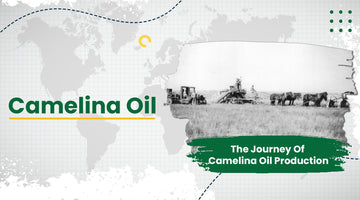
Camelina oil is a type of oil that has been creating quite a hype. Derived from the seeds of the Camelina sativa plant, this oil has a rich history dating back centuries. While it may not be as ubiquitous as olive or coconut oil, its nutritional profile and versatility have gathered attention from health-conscious consumers and culinary experts alike.
History of Camelina Oil
The story of Camelina oil traces back to time, with its origins rooted in ancient civilizations. Historically, it was cultivated in Europe for its culinary and medicinal properties. Camelina seeds were well-known for their high content of omega-3 fatty acids, antioxidants, and vitamin E, making them a valuable addition to diets for promoting heart health and overall wellness.
In today’s world, Camelina oil has been experiencing a resurgence in popularity. Its journey from traditional to contemporary superfood marks the shifting preferences of consumers towards natural, nutrient-rich ingredients. Today, it is not only valued for its nutritional benefits but also for its sustainability and eco-friendly production methods.
How is Camelina Oil farmed?
The cultivation of Camelina starts with careful selection of suitable land and optimal growing conditions. Known for its resilience to harsh climates and poor soil quality, Camelina has the ability to flourish in diverse environments, from arid plains to temperate regions. This versatility makes it an attractive crop for farmers looking for alternatives to traditional ones like corn or soy.
Seeds are sown in early spring, taking advantage of the longer daylight hours and warmer temperatures. Unlike some crops that require extensive irrigation and chemical inputs, Camelina is relatively low-maintenance, requiring minimal water and fertilizer.
As the plants mature, they develop small, pod-like structures containing the prized seeds. Harvesting typically occurs in late summer or early fall, once the seeds have reached full maturity. Unlike other oilseeds that require specialized equipment for extraction, Camelina seeds can be harvested using conventional farming machinery, minimizing the need for additional investments.

How we at “Ole Worlds Oils” began with the Camelina Oil Production Journey?
At "Ole Worlds Oils," our commitment to quality began at the source: our family-run farm in Washington state. Our farm, nestled in the Eastern Washington region, has weathered its share of challenges. Limited access to irrigation has shaped our crop choices, leading us to focus on sustainable practices that prioritize soil health and biodiversity. It was in 2009 that we embraced Camelina as a cornerstone of our farming ethos, drawn to its ability to enrich the land while offering a myriad of nutritional benefits.
Driven by a passion for sustainability and a belief in Carmelina's potential, my son, Travis, spearheaded our venture into Camelina production. With meticulous attention to detail and a dedication to quality, we established our own processing facility, ensuring that every drop of Camelina Gold Oil reflects our family's values and commitment to excellence.
From seed to crop, Camelina Gold embodies authenticity and purity, free from added chemicals, synthetic herbicides, or insecticides. We take pride in crafting a product that not only nourishes the body but also honors the land and the generations who have stewarded it before us.
Visit us at Ole World's Oil for more information!




